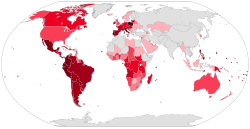This article needs additional citations for verification .(December 2020) |
| Catholic Church in Uruguay | |
|---|---|
| Spanish: Iglesia Católica en Uruguay | |
 | |
| Type | National polity |
| Classification | Catholic |
| Orientation | Latin |
| Scripture | Bible |
| Theology | Catholic |
| Polity | Episcopal |
| Pope | Leo XIV |
| Cardinal | Daniel Sturla |
| Region | Uruguay |
| Language | Latin, Spanish |
| Origin | 17th century Banda Oriental |
| Official website | iglesiacatolica.org.uy |
The Catholic Church in Uruguay is part of the worldwide Catholic Church, under the spiritual leadership of the pope.
Contents
- Overview
- History
- Careers
- Saints
- Institutes of Consecrated life
- Notable Uruguayan Catholic religious leaders
- See also
- References
- External links
| Part of a series on the |
| Catholic Church by country |
|---|
 |
| |